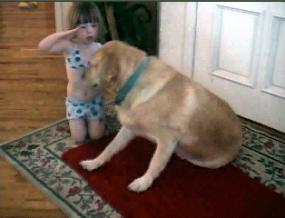She's Not Listening

Children develop their understandings of the social and physical world through interactions with toys, people and pets. From the child’s perspective, pets may have characteristics that render them similar to both people and toys. Sometimes, young children may assume that their pets are like toys and treat them as inanimate objects without feelings or free will. At other times, children may assume that like people, pets can understand English and can respond to their requests. How do young children respond when pets do not comply as they expect? How might interactions with pets support children as they construct new understandings about animals in general?
In this videative Avery is attempting to get her dog, Jasmine, to lay her head on the floor. When Jasmine does not understand what Avery wants, Avery speaks louder and pats Jasmine's head down with some firmness. She behaves as if Jasmine is not listening, as opposed to not understanding English. This stage of "listener blaming" is common among four-year-olds. By studying the entire videative, we can observe the innovative strategies that Avery invents to communicate her wish to her dog, including modeling the act of laying her head down herself. The choices Avery makes allow us to learn about her emerging understanding of her pet’s desires and needs. This videative has become a classic. It clearly portrays the growing theories children have about communication and persuasion.
Keywords: Fours, Pets, Parent-Child, Communication, Perspective, Mind of Other, videative
Length of videative: 3 text pages, 12 video subclips
Length of stand-alone master video clip: 1 minute, 50 seconds
